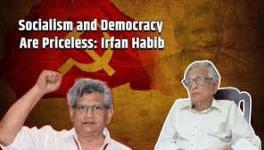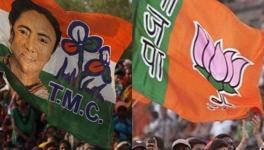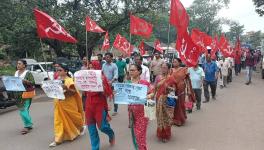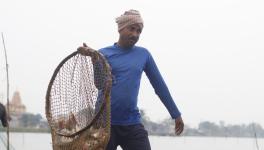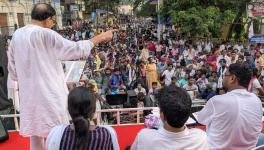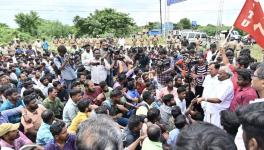Only Fighting for Economic Rights Won’t Uplift Dalit Community: Ramchandra Dom
Kolkata: Dr Ramchandra Dom, popularly known as the ‘people’s doctor’, is the first dalit to be elected to the polit bureau of the Communist Party of India (Marxist) at its recently concluded 23rd Party Congress held in Kannur, Kerala.
Dom, a seven-time Lok Sabha MP from CPI(M) representing the Birbhum (reserved) constituency and later Bolpur, fought poverty and social castigation right from childhood, but that did not deter him from becoming a medical practitioner. At present, he is general secretary of the Dalit Shoshan Mukti Manch , a pan-India organisation working for the uplift of the dalit community across country .
Ramchandra Dom
NewsClick spoke with the 63-year-old communist leader on his life and times, his involvement in the Left movement, and the challenges facing the dalit movement. Edited excerpts.
SC: Please tell us something about your childhood and struggles.
RD: I was born in the then poverty-stricken village of Chilla , located in an obscure part of Birbhum in a Scheduled Caste Dom family. My father and his brothers had only 1.5 bigha land for tilling, hence, they also had to work as rural artisans (carpentry) to sustain the families. We were six brothers and three sisters and I was the third among my siblings.
In our time (the 1960s and 70s) very few in the village could afford to study. My elder brother, despite being meritorious, had to leave studies halfway in Class 9. Two other brothers did not get a chance to study in schools and started working as rural artisans. Only one younger brother became a graduate and is in government service at present.
I had to fight social castigation at every step, though in my school, I was encouraged by my teachers, many of whom were Left inclined. They helped me in my studies and nurtured me like their own child.
In the 70s, during my school years, I drifted into the students’ movement and had to face social castigation and the then ruling party’s (Congress) torture, which even constituted a gana adalat (kangaroo court ) to try me during my school years for daring to pursue studies and at the same time getting involved in the student movement. I had to face assaults from the village heavyweights. However, soon my village took a Leftward turn and we united to protests against the oppression rained on me.
After passing secondary and higher secondary examinations, I got myself admitted in pre-medical course in 1976 after clearing the joint entrance examination. Again, the role of my teachers in this feat was commendable. Several teachers and well-wishers in my village also helped me financially to pursue the course in Kolkata.
In Kolkata , I initially stayed in the state Students’ Federation of India (SFI) office and then took a room in the slums of Dumdum Patipukur area along with another in-service person. By that time, I had also started taking private tuitions in Kolkata to earn some money.
In1977, a political change took place in West Bengal (the Left Front was voted to power) which helped me to get my SC stipends in time and I moved to the NRS (Nil Ratan Sarkar) hostel for medical students and got involved in building the SFI in various medical colleges.
In 1984, I completed my medical education and in 1986 moved to Birbhum as a doctor in a rural health centre. Later, I also became the BOMH (Block Medical officer of Health). However in 1989, the party -- CPI(M) – asked me to leave my government job, which I did. Later that year, the party nominated me to represent it from Birbhum in the Lok Sabha elections. Thus began my parliamentary life.
Amid all this, I was among the leading organisers of the youth movement and was central executive member of the Democratic Youth Federation of India or DYFI.
By the way, after clearing MBBS, I became the second person from my community to become a medical practitioner.
What is your view on the historical perspective of the dalit movement?
Dalit means oppressed and the movement for the uplift of the oppressed classes had started during the middle ages. Sri Chaitanyadeb started the Bhakti movement, whose foundation was based on uplifting the oppressed classes. This was the first organised movement to uplift the oppressed classes
In contemporary times, it was Dr Babasaheb Bhimrao Ambedkar who organised this movement. In Bengal, Jogen Mondal led the movement and was at its epicentre. Babasaheb gave an opportunity to dalits by ensuring reservations in government jobs, paving the way for their uplift in Independent India. However, it was not an all-conducive system.
What has been the role of the Left Front government in uplifting the marginalised classes in Bengal?
During the rule of the Left Front government, the school education sector was overhauled. School infrastructure was hugely improved. Stipends were given on time and SC/ST hostels started functioning in various parts of the state. Along with the mid-day meal scheme, the Left Front government encouraged the marginalised sections to join the education arena. In a nutshell, during the 34 years of Left rule in the state, the marginalised section hugely benefited.
You have said that reservation is not the only way for uplifting dalits in the country. Why?
Land rights, right to work, right to education, right to housing, right to health and political empowerment are key to destroying the roots of the caste-dominated Indian society. Without social empowerment, the movement for the uplift of dalits will be incomplete. Even now, in South Indian states, except Kerala, dalits do not have any right to enter many temples.
Economic and social exploitation are intrinsically related. As per our party, dalits, adivasis and other backward castes are key components of the class struggle in India. The fight for both social and economic rights is important. Only fighting on the economic agenda of dalits will not uplift the community, just as only fighting for the social agenda won’t help either. It is only by assimilating these two agendas can the real uplift of the oppressed classes take place. We Marxists are firmly of that opinion that for this, a revolutionary social change is needed.
What is the present condition of dalits in the country?
In North India, social and casteist divisions are extremely sharp. In West Bengal, due to the long Left rule and due to the social reformist movements, these divisions are not so severe. However, feudal remnants of the society are still very active. Hence, in present day West Bengal, dalits, adivasis and a section of women are becoming soft targets of lumpen elements. Here, the approach of the rulers on these issues is also important. Earlier, any such incident was dealt with iron hands. Now, due to the lacklustre attitude of the state government, such incidents are occurring frequently.
Since the past eight years, the country is being ruled by those from the stable of the Rashtriya Swayamsevak Sangh and Bharatiya Janata Party, who believe in the Manuwadi philosophy. Their main aim is to repackage the varna vyavastha (caste system) and re-strengthen it. Their basic aim is to build Hindu Rashtra by destroying the present Constitution.
This is like the country returning to the middle ages, wherein reactionary forces with regressive mindsets can be seen behind the rapid increase in sexual assaults and social oppression of dalits. Police records are only the tip of the iceberg. In Bengal, the ruling Trinamool Congress has ushered in lumpen raj, and in the country, the sangh pariwar is orchestrating this sort of terror.
During the last two years, that is, in the pandemic period, exploitation has increased manifold. This is the right time to build a strong resistance movement.
The avenues for dalits to get justice are being obstructed. On the other side, rampant privatisation initiatives have started at the behest of the Central and state governments, both pursuing neo-liberal policies and paving the way for corporatising the country’s natural resources, such as water , forests and land resources of adivasis.
In the private sector, there is no reservation. The worst hit sections are dalits, adivasis and other backward sections of the population. Education and employment are being dismantled due to rampant privatisation of public sector and freezing of recruitment in goverment departments in Central as well as state government units.
Reservation in education and employment in the private sector should, therefore, be introduced and if needed suitable amendments to the Constitution should be made.
Only social movements cannot address the concerns of dalits and adivasis. The fight to change the Central government and its privatisation mode should be taken up and social movements should go on alongside. Any one dalit organisation cannot make this happen. So, a correct trajectory should be taken. Spontaneity alone cannot make this happen.
What are the issues facing the dalit movement?
The sub-plans (for SC/STs) have been made redundant by the present government and subsequently the planning process for adivasis and dalits has also become redundant. These schemes should be immediately rejuvenated and statutory provision for sub-plans should be introduced for dalits and adivasi. Issues like upkeep of the sub-plans by the NITI Aayog and increasing budgetary allocation according to population ratio should be taken up.
The rights of maginalised sections of the society -- of water, forests and land rights of the adivasis -- should not be compromised. SC/ST hostels should not be. The movement for bolstering MNREGA (rural job guarantee scheme) should be taken up, and should be started in urban areas, too. Acts like Prevention of Atrocities against SC/STs should be strengthened.
What are the roadblocks before the dalit movement?
As the Union government is being run in fascist mode, any movement against it is being subdued by use of force, as seen in the Bhima Koregaon movement when many activists were jailed, and are still incarcerated. The space for democratic movements has been squeezed.
In the Uttar Pradesh elections, we have seen the fallout of micro social engineering, which is practically the utilisation of different divisions in the dalit society, pitting one against another to bring them under the Hindutva fold. This proved a dampener for the organised dalit movement in the country.
Get the latest reports & analysis with people's perspective on Protests, movements & deep analytical videos, discussions of the current affairs in your Telegram app. Subscribe to NewsClick's Telegram channel & get Real-Time updates on stories, as they get published on our website.










